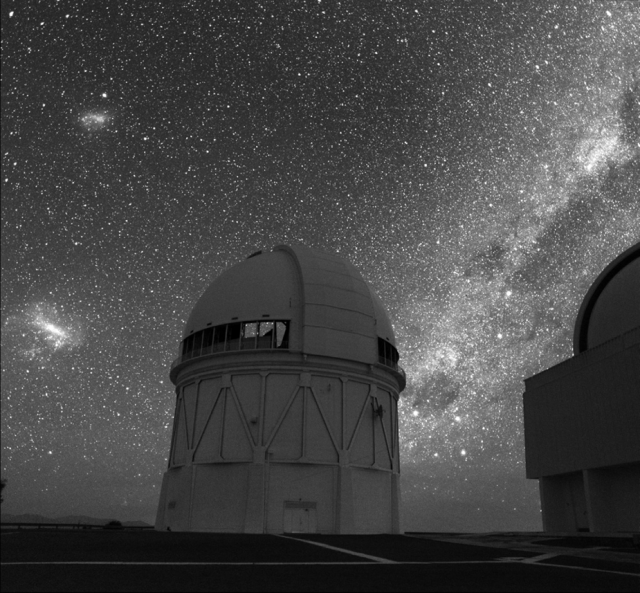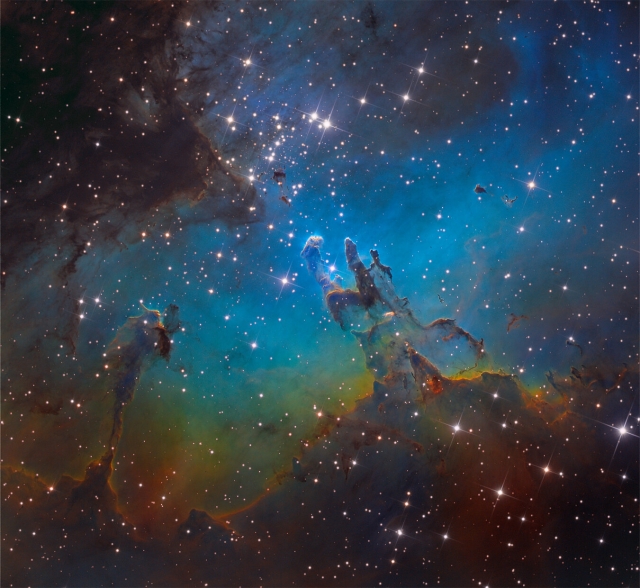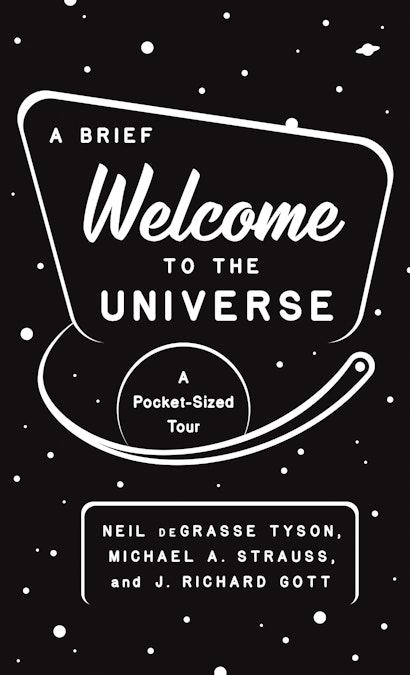Stars are so far away, they appear as unresolved points of light, even through modern telescopes. But seventeenth-century astronomers noticed a number of other objects in the sky that were extended and often fuzzy looking. They gave them the generic name nebula (plural nebulae), from the Latin word for cloud. We have already encountered a variety of nebulae in this book, including planetary nebulae, which result when red giants throw off their outer layers; the Orion Nebula, a region of intense star formation in which the surrounding gas fluoresces because of light from hot young stars; and even dark nebulae, the dust clouds that block light from background stars. There is yet another class, sensibly called spiral nebulae, because of their shape. The most prominent of these, the Andromeda Nebula, is bright enough to be seen with the naked eye under dark skies, far away from city lights. The astrophysicist Harlow Shapley, working at the beginning of the twentieth century, thought spiral nebulae were gas clouds within our own galaxy. The Milky Way is fuzzy looking itself. However, the spiral structure of the Milky Way disk that we discussed in the last chapter was unknown 100 years ago, because, living within the disk itself, we didn’t have a good understanding of its three-dimensional structure, making it harder to detect its resemblance to that larger class of objects. Still, the German philosopher Immanuel Kant had speculated as early as 1755 that the spiral nebulae were other “island universes,” that is, objects as large as the then entire known universe—the Milky Way. Given Shapley’s determination of the extent of the Milky Way and the small angular size of spiral nebulae on the sky, if Kant was right, this meant that they must be astonishingly—seemingly impossibly—distant, millions or tens of millions of light-years away.
Shapley found this notion to be completely implausible. The astrophysicist who made the observations that settled the question once and for all was Edwin Hubble.
Mount Wilson Observatory, where Hubble worked, overlooking the Los Angeles basin, had the largest telescope in the world at the time—100 inches (2.5 meters) in diameter. When Hubble took pictures of the Andromeda Nebula with this telescope in the 1920s, he resolved its diffuse light into individual stars, just as Galileo had discovered when he pointed his primitive telescope at the fuzzy arc of the Milky Way, 300 years earlier. Based on repeated observations of the Andromeda Nebula, Hubble identified several stars that periodically brightened and dimmed, which he understood to be a category of stars called Cepheid variables. In 1912, Henrietta Leavitt, who worked at Harvard, had found a relation between a Cepheid’s period of variability and its luminosity. Hubble was able to measure their periods, use Leavitt’s relation to infer their intrinsic luminosities, and, by measuring their observed brightness, find their distances. Hubble’s conclusion was stunning: the Andromeda Nebula lay at the then inconceivably large distance of almost a million light-years, putting it well beyond the known extent of the Milky Way.
Photographic images of the Andromeda Nebula, which do much better than the human eye, showed an angular diameter of 2° on the sky. Given that angular size, and Hubble’s distance, its true diameter must be about 30,000 light-years. Hubble was able to infer two compelling facts: (1) the Andromeda Nebula is comparable in size to the Milky Way, and (2) Andromeda lies well beyond the boundaries of the Milky Way.
Moreover, the sky was filled with other spiral nebulae, all much smaller in angular size and fainter than Andromeda. If they were similar to the Andromeda Nebula, they must be even farther away. This was a pivotal moment in the history of our understanding of the cosmos. Kant’s hypothesis that the spiral nebulae were other “island universes,” as large as the Milky Way itself, was correct. The boundaries of the known universe took a dramatic leap outward.
Two decades later, astrophysicists realized there was more than one class of Cepheid variable in the sky. When everything got straightened out, it turned out that Hubble had actually underestimated the distance to the Andromeda Nebula. Our modern value of its distance is 2.5 million light-years. Furthermore, modern digital imaging shows Andromeda’s outer fainter regions extending to a diameter of about 3° in the sky. With these larger values, we infer that the diameter of the Andromeda galaxy—yes, we now call it a galaxy—is about 130,000 light-years, somewhat larger than the Milky Way. Still, Hubble’s estimate was in the right ballpark, and his conclusion that Andromeda was another galaxy like the Milky Way was correct. Even a rough estimate was good enough to answer the big question.
Not all galaxies have a flattened disk—some are rounded, elliptically shaped, and dominated by old stars, with very little gas or dust. Hubble called these elliptical galaxies.
Most luminous galaxies are either ellipticals or spirals, but some galaxies have irregular shapes, not fitting into either category. You guessed it. We call them irregular galaxies. The Large Magellanic Cloud, a small satellite galaxy (14,000 light-years across) that orbits the Milky Way at a distance of about 160,000 light-years, falls into this category. It appears at the far-left edge of figure 1, next to the observatory dome. It is so close to us that it is easily visible to the naked eye.

Currently, the Milky Way and the Andromeda galaxy are falling together under the influence of their mutual gravitational attraction. When the galaxies collide, about four and a half billion years from now, the vastness of empty space between the stars ensures that the stars will slide past one another without colliding as the galaxies pass through each other. After the galaxies settle down in a few hundred million years, we expect them to merge and become an elliptical galaxy.
The stars in elliptical galaxies tend to be older than those in spirals, suggesting that most elliptical galaxies formed earlier in the history of the universe. The bulges of spirals share many properties with elliptical galaxies, suggesting they may have formed in similar ways. Gas that falls later onto an already-formed elliptical galaxy can cool before it has had time to form stars. The cooling causes the gas to lose energy, but not angular momentum, which can make it form a thin rotating disk. This process could make a spiral galaxy containing an elliptical bulge. The details of this process are still poorly understood and hotly debated.
A very long exposure with the Hubble Space Telescope has shown 10,000 faint, distant galaxies in a tiny, dull, and boring patch of sky equivalent to 1% of the area of the full Moon, which comes to about 1/26 millionth of the whole sky. Since we have no reason to suspect that this spot is unusual, we estimate that the number of galaxies we can see in the whole sky is 26 million times as many as we can see in that patch. That means 260 billion galaxies are within the reach of the Hubble Space Telescope. Each of these barely resolved spots of light is a galaxy, as large as the Milky Way, containing around 100 billion stars. With 1011 stars in each of more than 1011 galaxies, we infer that the observable universe contains at least 1022 stars. Neil boggled our minds with this number in chapter 1. Here we see where it comes from.
Astrophysicists started measuring the spectra of galaxies around 1915, a feat requiring photographic exposures many hours long. These first spectra showed features just like those seen in, G and K stars, which meant galaxies are made of stars. Edwin Hubble came to the same conclusion when he resolved individual stars in his photographic images of the Andromeda Nebula a decade later. The spectra of galaxies were refreshingly familiar to those accustomed to studying the spectra of ordinary stars. However, astrophysicists quickly noticed a significant difference. The spectral features from such elements as calcium, magnesium, and sodium were at wavelengths somewhat different from those seen in stars in the Milky Way, or in the laboratory. Typically, all the spectral lines from an individual galaxy were shifted systematically to the red. We call this phenomenon the redshift.
You can understand how the redshift originates by standing on a busy street corner and listening to a loud motorcycle ride by. You will hear a high-pitched whine as it comes toward you. Then as it reaches you and begins to travel away from you, the pitch of the engine’s roar drops noticeably as it zips past, sounding something like “Neeee-yaoooowwww!”
Sound from the motorcycle is a pressure wave in air, which, like light, has a certain wavelength and frequency. The higher the frequency (shorter the wavelength), the higher will be the pitch your ear perceives. As the approaching motorcycle emits a succession of wave crests, they crowd together resulting in a higher pitch. Conversely, the successive wave crests that reach you as the motorcycle recedes, are stretched out by the motion and thus have a lower pitch. This effect, described by Christian Doppler in 1842, works for light waves as well as sound waves: the motion of a distant star or galaxy imprints itself as a systematic shift in the features of its spectrum.
Galaxies have specific, even unique spectral features that correspond to their precise elemental makeup. The difference between the wavelengths of these elements in a particular galaxy and those same elements seen in Earth laboratories, interpreted as a Doppler shift, tells us how fast that galaxy is moving relative to us.
By 1915, Vesto Slipher, working at the Lowell Observatory (where Pluto was later discovered) had measured the Doppler shifts of 15 galaxies. Andromeda and two other galaxies were blueshifted, showing these galaxies were moving toward us, but all the rest—all the rest—were redshifted and thus moving away from us. The astronomical community has now measured the spectra of millions of galaxies; with only a handful of exceptions (like Andromeda), all of them show a redshift. We conclude that nearly all galaxies in the universe are moving away from the Milky Way. Are we in a special position, at the center of the motion of all the galaxies? What’s really going on? Once again, Edwin Hubble made the critical measurements.
After measuring the distance to the Andromeda Nebula using Cepheid variable stars, he continued this effort with other galaxies, using a variety of ways to estimate their distances. He then made a simple plot, comparing the distances of galaxies to their speeds. What he saw was a trend: the more distant the galaxy, the higher its speed of recession. Indeed, despite the substantial measurement uncertainties, he was able to conclude that speed v and distance d were proportional to each other. The velocity v was equal to its distance d multiplied by a constant, now called the Hubble constant in his honor. The Hubble constant is indeed constant throughout the universe at any given point in time, but it does change with cosmic epoch. The quantity H0 (pronounced “H-naught”) represents the value of the Hubble constant at present. This proportionality be-tween speed and distance soon became known as Hubble’s law.
Hubble’s first plot in 1929 included galaxies only out to a velocity v of about 1,000 kilometers per second, corresponding to a modern distance of about 50 million light-years. By 1931, Hubble and his colleague Milton Humason had extended the plot to include galaxies receding at 20,000 kilo-meters per second. That really cinched the case.
Is it really true that the Milky Way galaxy occupies a special position in the universe, a point away from which all other galaxies are moving? Such a notion would go against a recurring theme we have encountered, sometimes termed the Copernican Principle: that Earth is not in a special place in the universe. Ptolemy and the ancients put Earth at the center of the universe—it surely looks that way—but Copernicus demonstrated that Earth orbits the Sun. We then learned that the Sun is an ordinary main-sequence star, and although astrophysicists first thought that the Sun lay at a special place near the center of the Milky Way, Shapley’s more accurate work demonstrated that the Sun lies about halfway out from the center.
Hubble’s law, v = H0 d, implies that the Hubble constant H0 has units of a velocity v moving away from us (usually measured in kilometers per second) divided by a distance d, commonly measured in megaparsecs (Mpcs; i.e., millions of parsecs). A megaparsec is just 3.26 million light-years. The best estimate today is of the Hubble constant is H0 = 67 ± 1 (km/sec)/Mpc.
The Hubble expansion of the universe holds only on the scale of the distances between galaxies. Imagine pennies being taped to the surface of a balloon that is being filled with air. Galaxies, like the pennies, don’t expand, rather it’s the space between the pennies that’s expanding. Objects held together by gravity or other forces, including individual galaxies, individual stars and planets, and even ourselves, are not expanding. In fact, even the Milky Way and the Andromeda galaxies are gravitationally bound to each other, and therefore falling together, not moving apart. But on large scales, the galaxies, like the pennies on the expanding balloon, are moving apart. The measurements of redshifts, at first glance, seem to put the Milky Way at a special place relative to the other galaxies—at the center of the expansion. But that is not the case. Indeed, from the perspective of any one of those pennies, one sees all the other pennies receding. There is no center to the expansion on the balloon’s surface. There is no center to the expansion of the universe.
This essay is an excerpt from A Brief Welcome to the Universe: A Pocket-Sized Tour by Neil deGrasse Tyson, J. Richard Gott, and Michael A. Strauss.
About the Authors
Neil deGrasse Tyson is director of the Hayden Planetarium at the American Museum of Natural History and the author of many books, including Astrophysics for People in a Hurry. Twitter @neiltyson Michael A. Strauss is professor of astrophysical sciences at Princeton University. J. Richard Gott is professor emeritus of astrophysical sciences at Princeton. Twitter @JRichardGott

